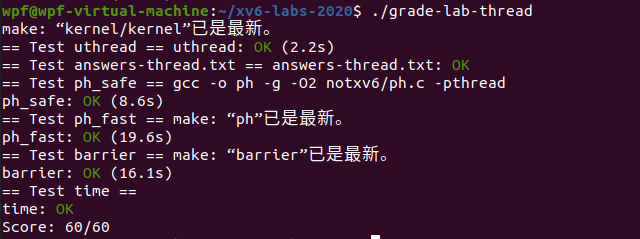MIT 6.S081 操作系统 LAB7:Multithreading
Lab: Multithreading
Uthread: switching between threads
实现一个用户级线程,跟内核线程的切换没什么区别。只要上课听懂了,复制内核代码就行了
只贴关键代码
线程上下文
struct context {
uint64 ra;
uint64 sp;
// callee-saved
uint64 s0;
uint64 s1;
uint64 s2;
uint64 s3;
uint64 s4;
uint64 s5;
uint64 s6;
uint64 s7;
uint64 s8;
uint64 s9;
uint64 s10;
uint64 s11;
};
struct thread {
char stack[STACK_SIZE]; /* the thread's stack */
int state; /* FREE, RUNNING, RUNNABLE */
struct context context;
};
线程切换
if (current_thread != next_thread) { /* switch threads? */
next_thread->state = RUNNING;
t = current_thread;
current_thread = next_thread;
/* YOUR CODE HERE
* Invoke thread_switch to switch from t to next_thread:
* thread_switch(??, ??);
*/
thread_switch((uint64)&t->context,(uint64)¤t_thread->context);
}
创建线程
设置好开始执行的位置和栈指针
void
thread_create(void (*func)())
{
struct thread *t;
for (t = all_thread; t < all_thread + MAX_THREAD; t++) {
if (t->state == FREE) break;
}
t->state = RUNNABLE;
// YOUR CODE HERE
t->context.ra=(uint64)func;
t->context.sp=(uint64)t->stack+STACK_SIZE;
}
上下文切换
汇编代码,与内核一致
保存ra,sp,callee saved registers
thread_switch:
/* YOUR CODE HERE */
sd ra, 0(a0)
sd sp, 8(a0)
sd s0, 16(a0)
sd s1, 24(a0)
sd s2, 32(a0)
sd s3, 40(a0)
sd s4, 48(a0)
sd s5, 56(a0)
sd s6, 64(a0)
sd s7, 72(a0)
sd s8, 80(a0)
sd s9, 88(a0)
sd s10, 96(a0)
sd s11, 104(a0)
ld ra, 0(a1)
ld sp, 8(a1)
ld s0, 16(a1)
ld s1, 24(a1)
ld s2, 32(a1)
ld s3, 40(a1)
ld s4, 48(a1)
ld s5, 56(a1)
ld s6, 64(a1)
ld s7, 72(a1)
ld s8, 80(a1)
ld s9, 88(a1)
ld s10, 96(a1)
ld s11, 104(a1)
ret /* return to ra */
Using threads
确定哈希表的线程安全
其实跟kalloc.c/freeList的意思是一样,上课听懂了就能理解
大致情况如下

在插入的时候加锁就行
性能上可以优化一下,变成每个桶一个锁,测试里能快个两秒左右吧
if(e){
// update the existing key.
e->value = value;
} else {
// the new is new.
pthread_mutex_lock(&locks[i]);
insert(key, value, &table[i], table[i]);
pthread_mutex_unlock(&locks[i]);
}
Barrier
线程间的屏障,可以参考barrier
大概意思就先到达这个点的线程要等待后面的线程,等到大家都执行到这里了,再统一放行,继续执行
static void
barrier()
{
// YOUR CODE HERE
//
// Block until all threads have called barrier() and
// then increment bstate.round.
//
pthread_mutex_lock(&bstate.barrier_mutex);
bstate.nthread++;
if(bstate.nthread==nthread)
{
bstate.nthread=0;
bstate.round++;
pthread_cond_broadcast(&bstate.barrier_cond);
}
else
{
int cur_round=bstate.round;
while(bstate.round==cur_round)
pthread_cond_wait(&bstate.barrier_cond , &bstate.barrier_mutex);
}
pthread_mutex_unlock(&bstate.barrier_mutex);
}
为了不被偷袭,防了一手虚假唤醒,其实不防也没事




【推荐】国内首个AI IDE,深度理解中文开发场景,立即下载体验Trae
【推荐】编程新体验,更懂你的AI,立即体验豆包MarsCode编程助手
【推荐】抖音旗下AI助手豆包,你的智能百科全书,全免费不限次数
【推荐】轻量又高性能的 SSH 工具 IShell:AI 加持,快人一步
· 分享一个免费、快速、无限量使用的满血 DeepSeek R1 模型,支持深度思考和联网搜索!
· 基于 Docker 搭建 FRP 内网穿透开源项目(很简单哒)
· ollama系列01:轻松3步本地部署deepseek,普通电脑可用
· 25岁的心里话
· 按钮权限的设计及实现